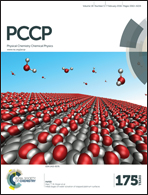Dependence of cobaltocenium diffusion in ionic liquids on the alkyl chain length of 1-alkyl-3-methylimidazolium cations†
Abstract
The electrochemical behavior of cobaltocenium (Cc+) on a Au(111) electrode was investigated in five 1-alkyl-3-methylimidazolium bis(trifluoromethylsulfonyl)amide ([Cnmim][Tf2N], n = 2, 4, 6, 8, or 10) ionic liquids (ILs) in the temperature range from 293.15 to 343.15 K by cyclic voltammetry and chronoamperometry. The redox couple of Cc+ exhibited a clear reversible one-electron reaction in all the [Cnmim][Tf2N] ILs. The diffusion coefficients of Cc+ increased with an increase in the alkyl chain length of [Cnmim]+ and a decrease in the viscosity of the IL upon elevating the temperature. The viscosity of the IL plays an important role in determining the activation energy for the diffusion of Cc+. The obtained results suggested that the alkyl chain length of [Cnmim]+ affects the strength of the interaction between Cc+ and the surrounding ion species. The results also clarified that the equation proposed by Sutherland adequately describes the diffusion of Cc+ in ILs when the effect of the type of IL and the temperature on the product of the Stokes radius of Cc+ and the Sutherland coefficient is considered.


 Please wait while we load your content...
Please wait while we load your content...